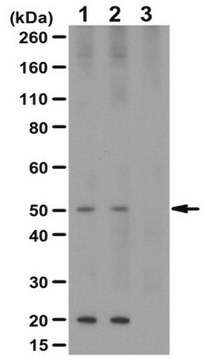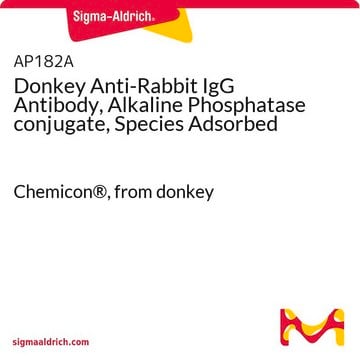Description générale
Pannexin-1 (UniProt: P60570) is encoded by the Panx1 (also known as Px1) gene (Gene ID: 315435) in rat. Pannexin-1 is a multi-pass membrane protein of the pannexin family that serves as a high-conductance, voltage-gated channel. It is widely expressed, including in cartilage, skin, spleen, heart, and brain. In the nervous system Panx1 transcripts have been detected in the cerebellum, cortex, lens, retina, pyramidal cells, interneurons of the neocortex and hippocampus. Three pannexin family genes (PANX1-3) have been identified in murine and human genomes. Pannexins share structural and functional similarities and play important roles in several physiological processes, including ATP release, Ca2+ homeostasis, and synaptic neurotransmitters release. Pannexins can also form intermixed channels and the intermixing is more evident between Pannexin 1 and 2. The level of intermixing is governed by the degree of N-glycosylation. Post-translational N-glycosylation plays a role in cell surface targeting. Pannexin-1 can also undergo S-nitrosylation, which can inhibit channel currents and ATP release. It has been shown that Pannexin-1 channel can release ATP in response to activation by TNF-alpha that requires activation of type-1 TNF receptors and downstream signaling through Src family kinases (SFK). It is shown that NMDARs, Src kinase and Pannexin-1 form a signaling complex, and activation of Pannexin-1 requires phosphorylation at Tyr308. Excitotoxic NMDA and glycine stimulation of N2a cells expressing Pannexin-1 is shown to increase phosphorylation at Tyr308, but not in cells expressing Pannexin-1 with Y308F substitution. Pannexin-1 has been linked to propagation of calcium waves, regulation of vascular tone, taste-bud function, and in tumor suppression in gliomas. Pannexin-1 channel opening can contribute to cell death and seizures under ischemic or epileptic conditions. (Ref.: Penuela, S et al. (2013). Biochim. Biophys. Acta 1828(11); 15-22; Weilinger, N et al. (2016). Nat. Neurosci. 19(3): 432-442).
Spécificité
This polyclonal antibody specifically detects pannexin 1 phosphorylated on tyrosine 308 in rat. Also predicted to react with human and chimpanzee.
Immunogène
A linear peptide corresponding to 13 amino acids surrounding phosphotyrosine 308 of rat pannexin-1.
Epitope: cytoplasmic domain
Application
Anti-phospho-Pannexin 1 (Tyr308) Antibody, Cat. No. ABN1680, is a highly specific rabbit polyclonal antibody that targets Pannexin 1 and has been tested in Immunohistochemistry and Western Blotting.
Research Category
Neuroscience
Western Blotting Analysis: A representative lot detected phospho-Pannexin 1 (Tyr308) in wt/mutant transfected N2a cells +/- stimulus (Weilinger, N.L., et. al. (2016). Nat Neurosci. 19(3):432-42).
Immunohistochemistry Analysis: A 1:100 dilution from a representative lot detected phospho-Pannexin 1 (Tyr308) in acute isolated hippocampal brain tissue slice (Courtesy of Dr Roger J. Thompson at University of Calgary).
Qualité
Evaluated by Western Blotting in HEK293T cells transfected with WT rat Panx1 and dominant active Src kinase (Y530F Src).
Western Blotting Analysis: A 1:1,000 dilution of this antibody detected phospho-Pannexin 1 (Tyr308) in 10 µg of HEK293T cells transfected with WT rat Panx1 and dominant active Src kinase (Y530F Src).
Description de la cible
~55 kDa observed; 48.07 kDa calculated. Uncharacterized bands may be observed in some lysate(s).
Forme physique
Affinity Purified
Format: Purified
Purified rabbit polyclonal antibody in PBS and 50% glycerol without azide.
Stockage et stabilité
Stable for 1 year at -20°C from date of receipt. Handling Recommendations: Upon receipt and prior to removing the cap, centrifuge the vial and gently mix the solution. Aliquot into microcentrifuge tubes and store at -20°C. Avoid repeated freeze/thaw cycles, which may damage IgG and affect product performance.
Autres remarques
Concentration: Please refer to lot specific datasheet.
Clause de non-responsabilité
Unless otherwise stated in our catalog or other company documentation accompanying the product(s), our products are intended for research use only and are not to be used for any other purpose, which includes but is not limited to, unauthorized commercial uses, in vitro diagnostic uses, ex vivo or in vivo therapeutic uses or any type of consumption or application to humans or animals.









